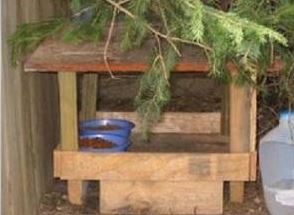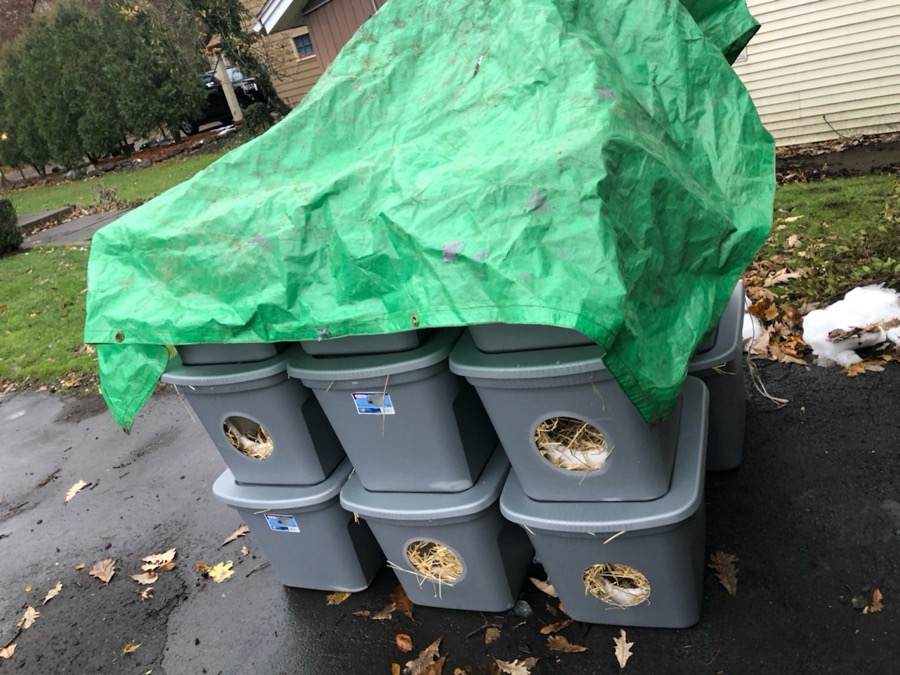Colony Management – Winter Weather Tips
Scroll down the page or click on a topic for links to helpful information from
feral cat experts.
SHELTER
FEEDING STATION
FOOD AND WATER
FOOD
WATER
WINTER SAFETY TIPS

SHELTER
Shelters keep feral cat colonies comfortable in cold and other harsh or severe weather conditions. Placing discreet shelters in quiet locations away from foot traffic helps keep cats from taking shelter in places where they are in danger or not welcome. There are endless variations of cat shelters. Visit our Colony Management-Shelters page for shelter ideas that you can build or buy pre-made.
FEEDING STATION
A feeding station establishes a specific area where the cats know to come for food, so they spend as little time exposed to the elements as possible.
To protect food and water from the elements, place them in a covered shelter (feeding station). This will protect the cats as they eat or drink. There are many variations and types of feeding stations to put food and water in. They can be purchased pre-made or you can build your own.
It’s important that one side of the feeding station be open because only a small opening or doorway could allow one cat to stay or sleep in there and keep the other cats out.
 A stand with a sloping roof, open on two sides, and off the ground, may be all that is needed for several cats to eat together.
A stand with a sloping roof, open on two sides, and off the ground, may be all that is needed for several cats to eat together.
A simple feeding station with a roof and sides will protect food and cats from precipitation and icy breezes during meal times.
Elevating the floor of the feeding station off the ground keeps food and paws warmer.
One of Feral Cat FOCUS’s favorite feeding stations is a Rubbermaid storage bin. It’s easy to clean because of the removable top and quick to put together. Small automatic feeders and water dishes will fit inside.
- Use a box-cutter to cut out most of one of the long sides, leaving a few inches off the ground to prevent flooding.
- Having difficulty cutting the plastic? Try blowing hot air from a hairdryer on the area where you plan to cut. This softens the plastic and makes it easier to cut through.

FOOD AND WATER
When temperatures drop, the colony will need extra calories to maintain energy levels. Provide extra food and water during the winter, and do your best to keep it from freezing.
Keep the feeding location neat and clean, for the health of the cats and for community relations. Keep the food dishes in one place to facilitate cleanup and to provide a tidy appearance, and again, remove feeding dishes within 30 minutes.
FOOD
- Feed the cats on a regular schedule. The cats will know when to come around, and both the food and the cats will spend less time exposed to the weather.
- The amount of food a cat needs depends on her size, the weather, and what other food sources are available. Cats vary in their needs, so some will eat considerably more food, others less.
- In the winter expect the colony to consume more food because they will need extra calories to maintain energy levels. In places where wet food may freeze, it is advisable to just feed dry food. If you know the colony will eat right away, and you plan to feed canned food, consider warming the food prior to arriving at the site and using insulated bags to keep the food warm during travel.
- On average, you can expect an adult feral cat to eat roughly 5.5 ounces of wet (canned) cat food and 2 ounces of dry food daily in temperate weather (add a half cup to that amount if only feeding dry food). In colder weather, make sure to feed larger portions than you usually do for an extra caloric boost.
- Observe the cats and the time it takes for the food to be eaten. If the cats eat all of the food in 15 minutes or less, put out a bit more.
- If you can keep it from freezing, feed wet food—it’s easier to digest, so cats save more energy for keeping warm. Consider warming canned food prior to arriving at the site and using insulated bags to keep the food warm during travel.
- Since wet food is also quicker to freeze, make sure you put out dry food too, or if you think the food is very likely to freeze, you may want to feed only dry food.
- Spray insulation foam into the underside of plastic feeding dishes to keep wet food from becoming fishcicles! Or chickencicles, turkeycicles, etc…
WATER
During wintertime, a common problem for caregivers is keeping the cats’ water from freezing. The cats need water, especially when dry food is the predominant food provided, which is often the case in winter when wet food itself can quickly freeze.
- The type of bowl can make a difference. The best bowls are deep, insulated and have relatively small openings compared to their volume. Use one made of thick plastic, like a Tupperware container – it takes water longer to freeze in one of them. Use double-layered bowls—they have an insulated air layer between the surface the water touches and the surface against the ground. Black or dark colored bowls will absorb solar radiation better.
- Position the bowl so it’s protected from the wind and, if possible, exposed to the sun. Try shielding the water dish from wind by placing it inside a small styrofoam cooler.
- Change water bowls twice daily to keep water from freezing. Use deep bowls rather than wide ones, and refill them with hot or warm water. If the colony is close to an outlet, heated electric bowls will also do the trick.
- Add a pinch of sugar to the water to keep it from freezing as quickly and to provide an energy boost for the cats.
- If there is a water source like a spigot, run the water slightly, since it won’t freeze as quickly as still water.
- Purchase a microwavable heating pad like a Snuggle Safe Pet Bed Microwave Heating Pad to use under the water bowl.
- Here are some more ideas on how to prevent water from freezing.
WINTER SAFETY TIPS
In addition to providing food, water, and shelter for cats in your neighborhood, observe these winter precautions to keep cats safe:
- Before starting your car, give the hood a tap and check between the tires—cats will sometimes crawl into the engine or hide underneath the car for warmth.
- Winter is the time of year for antifreeze, which often tastes irresistible to cats and other animals, but is toxic and deadly. Keep it out of reach and clean up any spills!
- Remember to shovel out cat shelters when you’re shoveling your own driveway. Cats in shelters can get snowed in, so keep entrances clear and shovel an exit for cats who may be taking refuge under bushes, porches, or other hiding spots.
- Stay away from salt and chemical melting products. These products can be toxic to animals and harmful to their natural snowshoes—paws!
